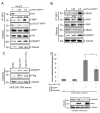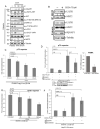IQGAP1 Is a Scaffold of the Core Proteins of the Hippo Pathway and Negatively Regulates the Pro-Apoptotic Signal Mediated by This Pathway
- PMID: 33672268
- PMCID: PMC7926663
- DOI: 10.3390/cells10020478
IQGAP1 Is a Scaffold of the Core Proteins of the Hippo Pathway and Negatively Regulates the Pro-Apoptotic Signal Mediated by This Pathway
Abstract
The Hippo pathway regulates a complex signalling network which mediates several biological functions including cell proliferation, organ size and apoptosis. Several scaffold proteins regulate the crosstalk of the members of the pathway with other signalling pathways and play an important role in the diverse output controlled by this pathway. In this study we have identified the scaffold protein IQGAP1 as a novel interactor of the core kinases of the Hippo pathway, MST2 and LATS1. Our results indicate that IQGAP1 scaffolds MST2 and LATS1 supresses their kinase activity and YAP1-dependent transcription. Additionally, we show that IQGAP1 is a negative regulator of the non-canonical pro-apoptotic pathway and may enable the crosstalk between this pathway and the ERK and AKT signalling modules. Our data also show that bile acids regulate the IQGAP1-MST2-LATS1 signalling module in hepatocellular carcinoma cells, which could be necessary for the inhibition of MST2-dependent apoptosis and hepatocyte transformation.
Keywords: Hippo; IQGAP1; LATS1; MST2; YAP1; bile acid; hepatocellular carcinoma.
Conflict of interest statement
The authors declare no conflict of interest. The funders had no role in the design of the study; in the collection, analyses or interpretation of data; in the writing of the manuscript, or in the decision to publish the results.
Figures







Similar articles
-
Mst2 and Lats kinases regulate apoptotic function of Yes kinase-associated protein (YAP).J Biol Chem. 2008 Oct 10;283(41):27534-27546. doi: 10.1074/jbc.M804380200. Epub 2008 Jul 17. J Biol Chem. 2008. PMID: 18640976
-
IQGAP1 Binds to Yes-associated Protein (YAP) and Modulates Its Transcriptional Activity.J Biol Chem. 2016 Sep 9;291(37):19261-73. doi: 10.1074/jbc.M116.732529. Epub 2016 Jul 20. J Biol Chem. 2016. PMID: 27440047 Free PMC article.
-
Interaction of LATS1 with SMAC links the MST2/Hippo pathway with apoptosis in an IAP-dependent manner.Cell Death Dis. 2022 Aug 8;13(8):692. doi: 10.1038/s41419-022-05147-3. Cell Death Dis. 2022. PMID: 35941108 Free PMC article.
-
The Hippo pathway in intestinal regeneration and disease.Nat Rev Gastroenterol Hepatol. 2016 Jun;13(6):324-37. doi: 10.1038/nrgastro.2016.59. Epub 2016 May 5. Nat Rev Gastroenterol Hepatol. 2016. PMID: 27147489 Free PMC article. Review.
-
One Hippo and many masters: differential regulation of the Hippo pathway in cancer.Biochem Soc Trans. 2014 Aug;42(4):816-21. doi: 10.1042/BST20140030. Biochem Soc Trans. 2014. PMID: 25109963 Review.
Cited by
-
Regulation of MST complexes and activity via SARAH domain modifications.Biochem Soc Trans. 2021 Apr 30;49(2):675-683. doi: 10.1042/BST20200559. Biochem Soc Trans. 2021. PMID: 33860801 Free PMC article. Review.
-
Navigating the ERK1/2 MAPK Cascade.Biomolecules. 2023 Oct 20;13(10):1555. doi: 10.3390/biom13101555. Biomolecules. 2023. PMID: 37892237 Free PMC article. Review.
-
FKBP51, AmotL2 and IQGAP1 Involvement in Cilastatin Prevention of Cisplatin-Induced Tubular Nephrotoxicity in Rats.Cells. 2022 May 9;11(9):1585. doi: 10.3390/cells11091585. Cells. 2022. PMID: 35563891 Free PMC article.
-
Knowledge graph aids comprehensive explanation of drug and chemical toxicity.CPT Pharmacometrics Syst Pharmacol. 2023 Aug;12(8):1072-1079. doi: 10.1002/psp4.12975. Epub 2023 Jul 20. CPT Pharmacometrics Syst Pharmacol. 2023. PMID: 37475158 Free PMC article.
-
Comprehensive analysis of the expression and prognosis for IQ motif-containing GTPase-activating proteins in hepatocellular carcinoma.BMC Cancer. 2022 Nov 1;22(1):1121. doi: 10.1186/s12885-022-10204-3. BMC Cancer. 2022. PMID: 36320006 Free PMC article.
References
-
- Matallanas D., Romano D., Yee K., Meissl K., Kucerova L., Piazzolla D., Baccarini M., Vass J.K., Kolch W., O’Neill E. RASSF1A elicits apoptosis through an MST2 pathway directing proapoptotic transcription by the p73 tumor suppressor protein. Mol. Cell. 2007;27:962–975. doi: 10.1016/j.molcel.2007.08.008. - DOI - PMC - PubMed
Publication types
MeSH terms
Substances
LinkOut - more resources
Full Text Sources
Other Literature Sources
Molecular Biology Databases
Research Materials
Miscellaneous

